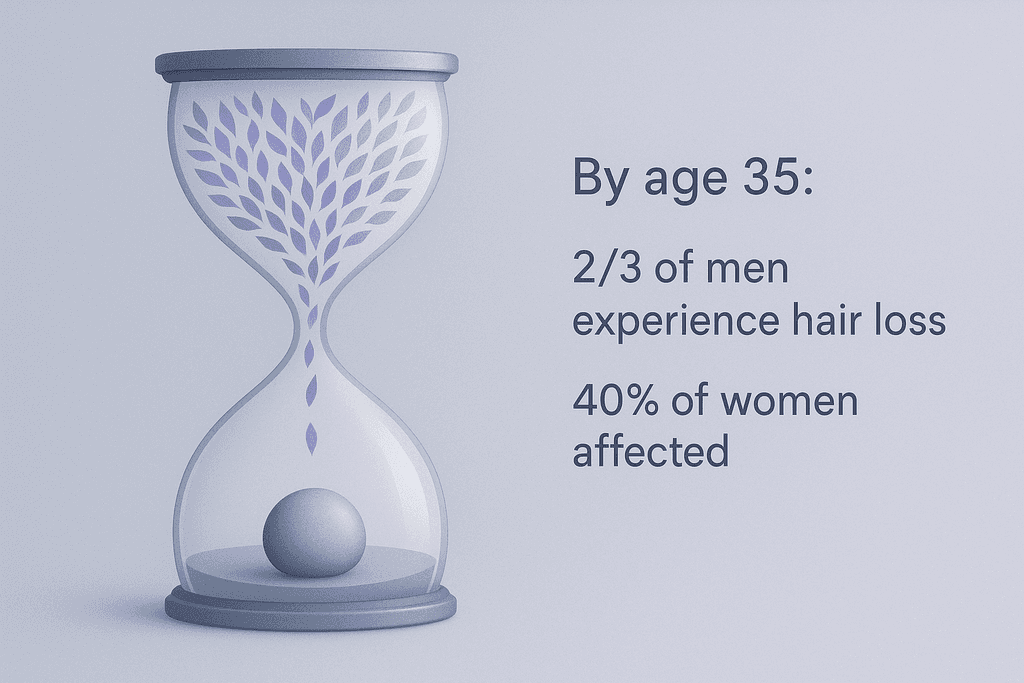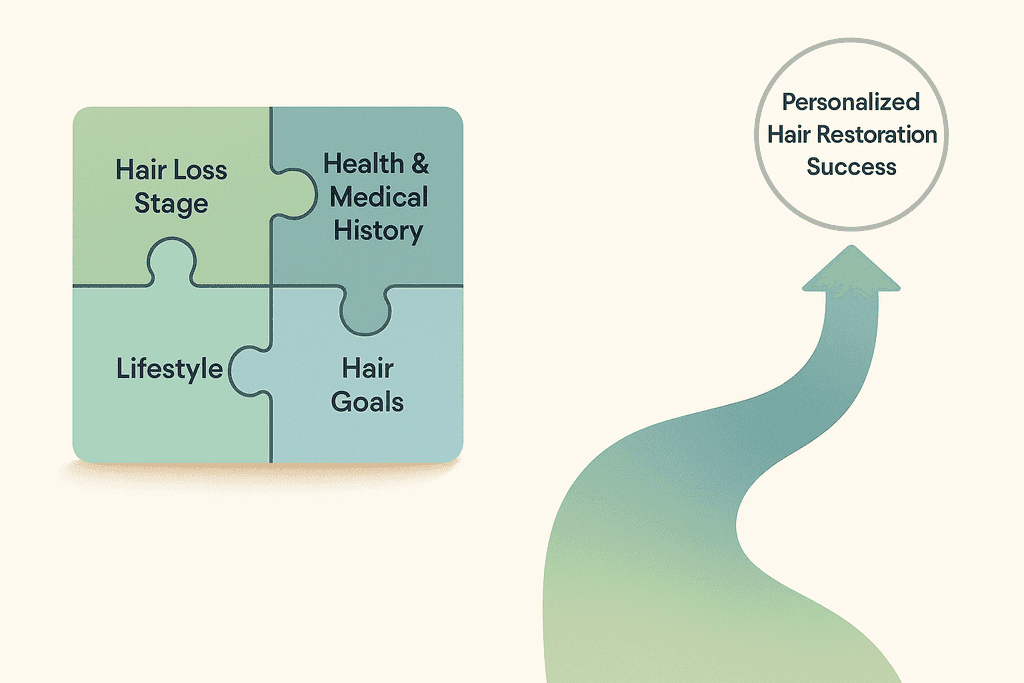Hair loss affects over 80 million Americans, yet misconceptions about restoration treatments run rampant. From miracle cures to surgical fears, separating fact from fiction is crucial for those considering hair restoration options. Understanding the truth behind these myths can empower you to make informed decisions about effective treatments like PRP therapy for natural hair regrowth.
Table of Contents
Understanding Hair Loss and Restoration
Did you know that by age 35, about two-thirds of American men will experience some degree of hair loss? It’s not just a “guy thing” either – women make up 40% of hair loss sufferers in the United States. Hair loss can be a sensitive topic, often impacting self-esteem and confidence.
Hair loss has been a concern for centuries, with remedies dating back to ancient Egypt. People tried everything from lion fat to crocodile dung (yuck!) to regrow their locks. Thankfully, we’ve come a long way since then.
Today’s hair restoration methods are much more scientific and effective. Here are some popular options:
- Medications like minoxidil and finasteride
- Hair transplant surgeries
- Platelet-rich plasma (PRP) therapy
- Low-level laser therapy
- Scalp micropigmentation
Each method has its pros and cons, and what works for one person might not work for another. That’s why it’s crucial to consult with a hair restoration expert to find the best solution for your unique situation.
Let’s look at some common causes of hair loss:
- Genetics (androgenetic alopecia)
- Hormonal changes
- Medical conditions
- Medications and treatments
- Stress and lifestyle factors
Understanding the root cause of your hair loss is key to finding the right treatment. At Beauty & Fly Aesthetic Wellness, we offer PRP Therapy for Hair Loss, which uses your body’s own growth factors to stimulate natural hair regrowth.
Before diving into any treatment, it’s important to separate fact from fiction. Many myths surround hair loss and restoration, leading to confusion and sometimes ineffective DIY attempts. Hair loss myths can be misleading, so it’s crucial to get accurate information from trusted sources.
| Hair Loss Statistic | Percentage |
|---|---|
| Men experiencing hair loss by age 35 | 66% |
| Women among hair loss sufferers | 40% |
| People who experience some hair loss by age 50 | 85% |
As we explore hair restoration myths and facts, remember that each person’s hair loss journey is unique. What matters most is finding a solution that works for you and helps you feel confident again.
Debunking Common Hair Restoration Myths
Let’s face it – hair loss can be a sensitive topic. With so much misinformation out there, it’s easy to get confused about what really works. Let’s clear up some common myths about hair restoration.
Myth: Hair transplants always look unnatural
Not true! Modern techniques like FUE (Follicular Unit Extraction) can create incredibly natural-looking results. Skilled practitioners carefully place individual hair follicles to match your existing hair pattern.
Myth: Only men experience hair loss
While male pattern baldness is common, women make up a significant portion of hair loss sufferers. Factors like hormones, stress, and genetics can affect anyone’s hair.
- 40% of women experience visible hair loss by age 40
- Pregnancy, menopause, and thyroid issues can all contribute
- Female pattern hair loss often looks different from male loss
Understanding that hair loss affects everyone can help reduce stigma and encourage people to seek treatment.
Myth: Hair restoration is a one-time procedure
Hair loss is often progressive. While a single treatment can provide great results, maintaining those results may require ongoing care. This could include follow-up procedures or medications to prevent further loss.
Myth: Wearing hats causes hair loss
Good news for hat lovers – this one’s false! Normal hat-wearing doesn’t damage hair follicles. However, extremely tight hairstyles can cause traction alopecia over time.
Proven Hair Restoration Techniques
Now that we’ve busted some myths, let’s look at treatments that actually work. Science has come a long way in understanding hair loss and developing effective solutions.
- PRP Therapy: Uses your own platelet-rich plasma to stimulate hair growth
- FUE Transplants: Minimally invasive method of moving individual hair follicles
- Medications: FDA-approved options like finasteride and minoxidil
- Low-Level Laser Therapy: Uses light energy to encourage hair growth
Each of these methods has its own pros and cons. The best choice depends on your individual situation and goals.
At Beauty & Fly, we specialize in PRP Therapy for hair loss. This natural approach harnesses your body’s own healing powers to revitalize hair follicles. It’s a great option for those looking for a non-surgical solution.
What to Expect from Hair Restoration Treatment
Thinking about hair restoration? Here’s a quick rundown of what the process typically looks like:
| Stage | What Happens | Timeframe |
|---|---|---|
| Initial Consultation | Assess hair loss, discuss goals, determine best treatment | 1-2 hours |
| Treatment Planning | Customize approach based on your needs | Varies |
| Procedure | Perform chosen treatment (e.g. PRP therapy, transplant) | 1-8 hours |
| Initial Results | First signs of improvement | 3-6 months |
| Full Results | Maximum benefit of treatment visible | 12-18 months |
Remember, hair growth takes time. Don’t get discouraged if you don’t see immediate results. Consistency and patience are key.
Maintenance is also crucial for long-term success. This might include follow-up treatments, using specialized hair care products, or taking medications to prevent further loss. Your provider should work with you to create a personalized plan.
Curious about what real patients experience? The International Society of Hair Restoration Surgery (ISHRS) offers insights from actual hair transplant recipients. Their stories can give you a better idea of what to expect.
Hair restoration isn’t just about getting more hair – it’s about feeling confident in your appearance. With the right approach and realistic expectations, you can achieve natural-looking results that help you look and feel your best.
Choosing the Right Hair Restoration Approach
When it comes to hair restoration, there’s no one-size-fits-all solution. Each person’s hair loss journey is unique, which is why personalized treatment plans are crucial for success. Let’s break down the key factors to consider when exploring your options:
- Current hair loss stage
- Overall health and medical history
- Lifestyle and daily routines
- Budget and time commitment
- Long-term hair goals
Understanding these factors helps create a tailored approach that aligns with your specific needs. It’s also important to have realistic expectations. While modern hair restoration techniques can yield impressive results, they’re not magic wands.
Balancing hopes with reality is key to satisfaction with your treatment outcomes. This is where expert guidance becomes invaluable. A skilled practitioner, like Catherine Curtin at Beauty & Fly, can assess your situation and recommend the most suitable options.
- Evaluate non-surgical options first
- Consider combination therapies for enhanced results
- Factor in maintenance requirements
- Discuss potential side effects and recovery time
One common misconception is that hair restoration always means surgery. In fact, many people achieve significant improvements with non-invasive treatments. For instance, PRP therapy for hair loss at Beauty & Fly harnesses your body’s natural growth factors to stimulate hair follicles, often with minimal downtime.
Remember, the journey to fuller hair is a process, not an overnight transformation. Patience and consistency are your allies in achieving the best possible outcome. By working closely with a trusted professional and staying informed about your options, you’re setting yourself up for hair restoration success.
For those curious about common hair transplantation myths, this article on myths and truths about hair transplantation offers some eye-opening insights. It’s a great resource to help separate fact from fiction as you explore your options.
Wrap-up
Hair restoration can be a complex topic, but understanding the facts helps you make better choices. We’ve cleared up some common myths and highlighted key truths about hair loss treatments. Remember, what works for one person may not work for another.
Consulting with a hair restoration expert is crucial. They can assess your specific situation and recommend the best approach. At Beauty & Fly, we offer personalized PRP therapy for hair loss, which uses your body’s own growth factors to stimulate natural hair regrowth.
Don’t let misinformation hold you back from exploring your options. Whether you’re just starting to notice thinning or have been dealing with hair loss for years, there are solutions worth considering. Take the next step in your hair restoration journey by booking a consultation with a qualified professional who can guide you through the process.
Ready to learn more? Check out our FAQ section below for answers to common questions about hair restoration treatments.
Frequently Asked Questions About Hair Restoration
Is hair restoration painful?
Hair restoration treatments like PRP therapy are generally well-tolerated. Most patients report minimal discomfort during the procedure. We use topical numbing agents to ensure your comfort. After treatment, you might feel some mild soreness, but it typically subsides quickly.
How long do results last?
The longevity of hair restoration results can vary. With PRP therapy, many patients see improvements lasting 12-18 months. However, factors like age, genetics, and overall health play a role. Regular maintenance treatments can help extend and enhance your results.
Can women undergo hair restoration?
Absolutely! Hair restoration isn’t just for men. Women experiencing thinning hair or hair loss can benefit greatly from treatments like PRP therapy. At Beauty & Fly, we tailor our approach to address the unique needs of female hair loss patterns.
What’s the best age to start treatment?
There’s no “perfect” age to start hair restoration. The ideal time is when you first notice concerning hair loss. Early intervention often leads to better outcomes. During your consultation, we’ll assess your individual situation and recommend the most appropriate treatment plan.
How many sessions are needed?
The number of sessions varies based on your specific needs and goals. For PRP therapy, we typically recommend an initial series of 3-4 treatments spaced about a month apart. After that, maintenance sessions every 6-12 months help sustain results. We’ll create a personalized plan during your consultation.
Are there any side effects?
Side effects from hair restoration treatments like PRP are generally mild and temporary. You might experience some redness, swelling, or tenderness at the treatment site. These usually resolve within a day or two. Serious side effects are rare, especially when performed by an experienced provider like Catherine Curtin at Beauty & Fly.


